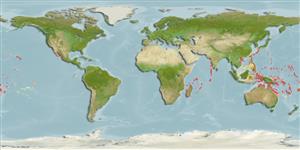>
Kurtiformes (Nurseryfishes, cardinalfishes.) >
Apogonidae (Cardinalfishes) > Apogoninae
Etymology: Apogon: Greek, a = without + Greek pogon = chin, beard (Ref. 45335); indicus: From the Latin indicus meaning 'of India' - in reference to the Indian Ocean where the holotype was collected and where it is the only member of the A. erythrinus complex (Ref. 40822).
More on author: Greenfield.
Environment: milieu / climate zone / depth range / distribution range
экология
морской демерсальный; пределы глубины 6 - 8 m (Ref. 40822). Tropical
Indo-Pacific: Mauritius to Kiribati.
Size / Вес / Возраст
Maturity: Lm ? range ? - ? cm
Max length : 3.8 cm SL самец/пол неопределен; (Ref. 40822)
Краткое описание
определительные ключи | морфология | морфометрия
колючие лучи спинного плавника (общее число) : 7; членистые (мягкие) лучи спинного плавника (общее число) : 9; колючие лучи анального плавника: 2; членистые (мягкие) лучи анального плавника: 8. Differs from other members of the A. erythrinus complex by having the following characteristics: from A. erythrinus by having a shorter second dorsal fin spine not reaching base of third ray of second dorsal fin when depressed and by usually having 13 pectoral fin rays (versus 14); from A. marquesensis by lacking scattered dark chromatophores on sides of caudal peduncle that extend anteriorly as a band to vertical from caudal fin base to vertical from end of dorsal and anal fin rays (pigment extends forward as a band in A. marquesensis) and by usually having 13 pectoral fin rays (versus 14); from A. susanae by usually having 13 pectoral fin rays (versus 14), by having pigment along the base of the second dorsal fin and on the dorsal surface of the caudal peduncle (pigment lacking in A. susanae), by usually having a well-developed suborbital triangle of pigment (usually lacking or faint in A. susanae, and by having a well-developed pigment blotch on caudal fin base (variable, but often faint or absent in A. susanae (Ref. 40822). Further characterized by having 23 pored lateral line scales; predorsal scales 6; large scales between first dorsal fin and lateral line 2, with smaller third scale at base of dorsal fin; circumpeduncular scales 14; total gill rakers 15, developed gill rakers 7; without free edge of skin near anterior nasal opening (Ref. 93839).
Life cycle and mating behavior
Maturities | размножение | Spawnings | Egg(s) | Fecundities | личинки
Mouthbrooders (Ref. 240). Distinct pairing during courtship and spawning (Ref. 205).
Greenfield, D.W., 2001. Revision of the Apogon erythrinus complex (Teleostei: Apogonidae). Copeia 2001(2):459-472. (Ref. 40822)
Статус Красного Списка МСОП (Ref. 130435)
Угроза для людей
Harmless
Использование человеком
дополнительная информация
инструменты
Специальные отчеты
Скачать в формате XML
ресурсы в Интернет
Estimates based on models
Preferred temperature (Ref.
123201): 25.4 - 29.3, mean 28.4 °C (based on 1889 cells).
Phylogenetic diversity index (Ref.
82804): PD
50 = 0.5000 [Uniqueness, from 0.5 = low to 2.0 = high].
Bayesian length-weight: a=0.01479 (0.00690 - 0.03171), b=3.09 (2.91 - 3.27), in cm total length, based on LWR estimates for this (Sub)family-body shape (Ref.
93245).
Trophic level (Ref.
69278): 3.3 ±0.4 se; based on size and trophs of closest relatives
устойчивость к внешним воздействиям (Ref.
120179): высокий, минимальное время удвоения популяции до 15 месяцев (Preliminary K or Fecundity.).
Fishing Vulnerability (Ref.
59153): Low vulnerability (10 of 100).
